Tango is like homelessness
Text: Ray Batchelor. Images: Joana Freitas.
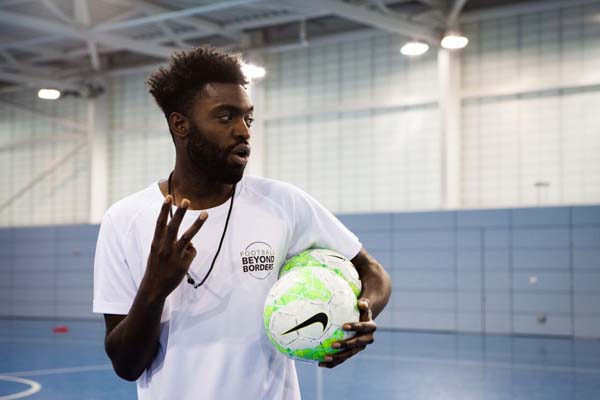
Jack Badu, co-leader of the Football Tango Project, is Head of Coaching at Football Beyond Borders, a thriving charity supporting young disadvantaged people through football. Jack has devised some tango-based football ‘drills’ or exercises and he is explaining one of them here to players from Homeless FA. Image: Joana Freitas.
Tango is like homelessness
Football coach, Jack Badu and I had worked hard preparing the Football Tango Workshop we ran for Homeless FA at St Georges’ Park, the purpose-built ‘Home of English Football.’ Yet nothing prepared us for someone saying “Tango is like homelessness.” Really? Of course we both recognised the connections between tango and football: both involve a physical, social activity in a prescribed space in which people behave according to rules and within a culture. These connections are the foundations of our Football Tango Project. Funded by Bucks New University, supported by Stonewall, the LGBT campaigning group and informed by dialogue with the UK Football Association, Jack and I ran a sequence of research workshops with Bucks student footballers which established the viability of combining tango and football. Doing so improves players’ physical co-ordination on the field – a kind of second by second, spatial ‘social intelligence’. In addition, the unsettling experience of asking players to dance with each other – men with men, women with women, women leading men and occasionally, men leading women – makes people think. We exploit this interruption to ‘common-sense’ assumptions as an opportunity to open up discussions about sexism and about homophobia and its causes. In football, homophobia is worse than in wider society.
Of course, there are well-recognised connections between football and supporting vulnerable people. Football Beyond Borders (FBB), where Jack is Head of Coaching, is a thriving organisation dedicated to using football to help disadvantaged young people. Jack learnt some tango and successfully worked tango principles into a dozen or so football ‘drills’ or exercises which he regularly uses in his work. Homeless FA offers football to people affected by homelessness and in doing so, gives players unique opportunities to meet their football heroes, to travel and to represent England in ‘Team England’ playing internationally against teams of people affected by homelessness from other countries. Players’ self-esteem increases. Even so, working at this level demands commitment, team-work and self-discipline. Developing these personal skills can open up ways out of homelessness and change lives.
Every player at St George’s Park on December 10th, 2015, had competed hard for their place in Team England. These days were intended to celebrate their achievement. If, in the coming months, they show sufficient maturity, self-discipline, and team spirit, some of them can become fully fledged volunteers for Homeless FA – a role with further privileges. Homeless FA seeks to counter racism, sexism, homophobia and all other forms of discrimination. Inviting the Football Tango Project to run a workshop was only the latest in a sustained programme of creative approaches to countering prejudices.
So, tango is connected to football, football is connected to homelessness – but a direct connection between tango and homelessness?
That was the surprising result of this unique event.
In all, the 42 participants were made up mostly of players, with some volunteers and a few members of staff – roughly a 70%/30% split between men and women. Matt Coombes came down from Newcastle to help us. Matt is a designer specialising in the therapeutic dimensions of design and a dedicated, experimental tango dancer who, like me, can lead and follow. None of the players had been told what the workshop consisted of except that it would be ‘challenging’. Having completed a fitness test, they sat recovering in side seating in the vast Futsal gym. As they caught their breath, I gave a brief explanation of the background to the day, of tango’s historical origins in Argentina (including how, in a society where men outnumbered women by seven to one, it was ‘normal’ for men to practice dancing with each other), and of the sorts of things we would be asking them to do. Anxieties surfaced immediately: “You mean I’m gonna have to dance with another guy?” “Yep.” A slow, despairing shake of the head confirmed that to this wiry, tattooed, short-haired man – the epitome to some, perhaps, of ‘homeless’ – this was a ‘challenge’ he neither expected, nor welcomed.
We began with simple tango walking exercises. There were episodes of horseplay, wisecracking and general unruliness, a standard defence mechanism for those who fear they may be in danger of being humiliated – but not good behaviour for those wanting to become Homeless FA volunteers. The players were asked to form couples, holding each other in a relaxed, practice hold. They did it, even if some did so with palpable unease. And yet, as the exercises in leading and following unfolded – and especially once Jack engaged them in the first of the tango-based football drills – the unease gradually subsided. After the break, more tango exercises, this time, adopting a dance hold – more like ‘real’ dancing – and then one of the objectives of the workshop: a whole three and a half minute tango, danced in couples in dance hold, in single file anti-clockwise around the dance floor in ‘the line of dance’, without breaking off, without talking to each other and with each dancer not only being attentive to the person immediately opposite them, but in order to ensure the orderly line of dance kept moving, attentive to everyone else in that space. This was ‘dance as society.’
And this society worked, more or less. Once the music stopped, there was spontaneous applause.
Was this ‘Queer Tango?’ Our approach certainly drew on it. Queer Tango, challenges gender the conventions of tango within an overt social and political context, and our work arose, in part, out of my involvement with it – but that is not how we presented the workshops to the players. There was already plenty in the workshops to ‘challenge’. The specialised language and concepts of Queer Tango would have only erected further barriers to engagement, barriers which, in the time available, might have proved insuperable.
As the applause died down, Matt and I gave a brief tango demonstration of intercambio, smoothly swapping who was leading and who following throughout the dance – prompting yet more applause. Then, finally, the disciplined riotousness of Jack’s last and most sophisticated tango-based, football drill: players playing in couples as one player (and penalties awarded if they came apart), with two teams on the pitch, one off and around the pitch to give and receive footballs and four sets of goal posts. They threw themselves into it.
By the end of the workshop, it was evident most had become relaxed enough thoroughly to enjoy it – but had it made them think? Thirty minutes later at the debriefing session in the Terry Venables Lecture Theatre, much was said that was to be welcomed and perhaps expected: the weirdness of same sex couple dancing, with one woman player who self-identified as gay, saying it was dancing with other women which was unsettling, because of the proximity of bodies. Among the men, free acknowledgement of the near universal taboo on physical contact between men except in very proscribed circumstances, because otherwise – well, otherwise what? People will think you are gay – and how bad is that? One of them said: “I think that the way people discriminate against people for their sexuality is wrong… People need to be more educated. I saw some of the guys finding it difficult being nose to nose, a bit intimidating. I was embarrassed too… It was good though.”
Pretty much everyone recognised the commonalities between football and tango. And most had enjoyed it. “I thought it was a bit weird but I suppose it teaches you to trust your players, if you can dance with them then you can certainly play football with them. You’ve got to trust them to lead you and they can trust you to lead them. I thought it was pretty cool.” And one player reminded us all that people affected by homelessness may have particular reasons to be jealous of their personal spaces: “I think touching each other, looking at each other and holding each other made people feel uncomfortable. I think it’s a mixture of the romantic implications and the fact that [in] the type of group that we are, a lot of people suffer from anxiety and personal space issues. I think people struggle with others touching them and getting in that space.”
But: ‘Tango is like homelessness?’ This unexpected observation came from the players themselves. Most of them had started out with a set of views about what tango is like, about who dances it, how it is danced and why. Most people have a set of beliefs about what homelessness is like and what a homeless person is like – “all about nicking your wallet” – and why. For most of the players, the workshop had dispelled preconceptions about tango: “I liked having the history explained – that was interesting.” They made the connection: tango is like homelessness because as each addresses the problems facing them, so they change other people’s preconceptions about homelessness and the people it affects. “You don’t look like a homeless person” a journalist had said to one of the players interviewed for a national newspaper. Many people are affected by homelessness. Homeless FA players want to change attitudes both towards homelessness, themselves and towards others like them.
They certainly changed mine.
We were thrilled that Emily Whyte at Homeless FA wrote to us afterwards:
‘Thanks again for the amazing workshop on Thursday – it was fun and informative and definitely allowed players to work outside their comfort zone. It also had an impact on players… in particular those who were not confident or willing to take part initially and managed to change their attitude and engage… I think it will have a lasting effect on them!’
The Football Tango Project looks forward to more workshops with Homeless FA players and with others including, perhaps, players from the professional game where, despite much fine language, changes in attitudes towards sexism and homophobia are long overdue.
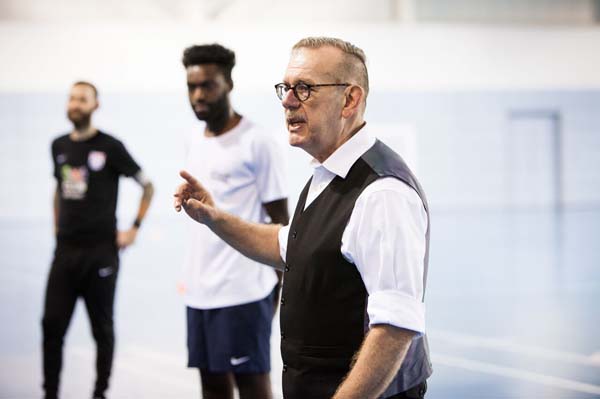
Dr Ray Batchelor from The Queer Tango Project explaining things to players from Homeless FA at a recent Football Tango workshop. With football coach, Jack Badu Ray is co-leader of the Football Tango Project. All the players from Homeless FA have been affected by homelessness. Homeless FA offers them opportunities to train as footballers. It organised the workshop as part of its programme of measures to counter sexism and homophobia in football. Image: Joana Freitas.
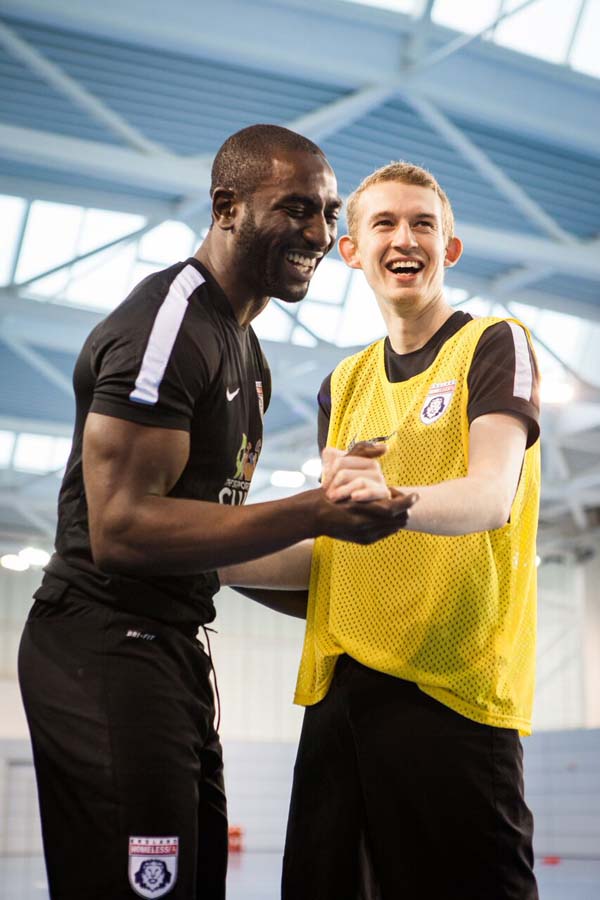
Players from Homeless FA dancing ‘gender-blind’ tango at the Football tango Workshop – and enjoying it! Players initial unease at being asked to form same gender couples gradually gave way to a more relaxed approach. This experience was used to open up discussions about sexism and homophobia in football in the debriefing session which followed the practical workshop. Image: Joana Freitas.
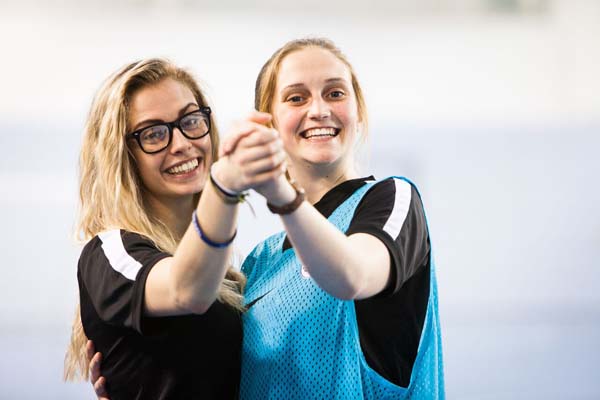
Just as men are asked to dance ‘the woman’s role’ so women get opportunities to lead – in this case, another woman, but in a Football Tango Workshop, it could as easily be a man. The parallels with the kinds of behaviour expected of, or ‘allowed’ in wider society were there to be teased out in the discussions which followed. Image: Joana Freitas.
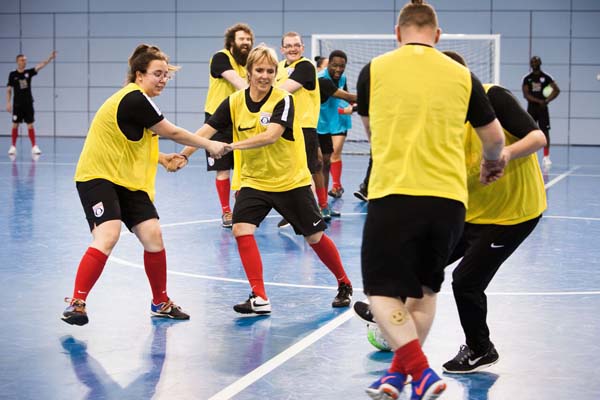
In this football ‘drill’ or exercise devised by football coach, Jack Badu, players have to play football in couples as one player – and they must stay together. If one or other splits off, the opposite side is awarded a penalty kick. Each player is obliged to co-operate with their partner towards achieving the common objective of securing possession of the ball and scoring a goal in one of the four sets of goal posts. Image: Joana Freitas.
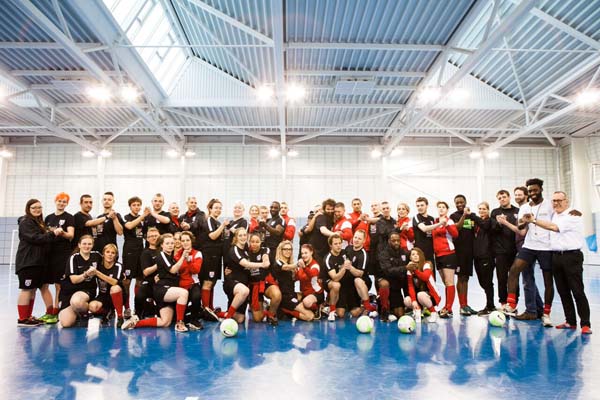
In a deliberate imitation of the photograph used in The Football Tango Project publicity which shows players from Manchester United posing in tango hold in 1913 at the height of ‘Tangomania,’ players from Homeless FA have posed in similarly unusual poses for a football team. From the right are Ray Batchelor and Jack Badu, with Matt Coombes, a designer and tango dancer who travelled from Newcastle to be part of the workshop. Image: Joana Freitas.